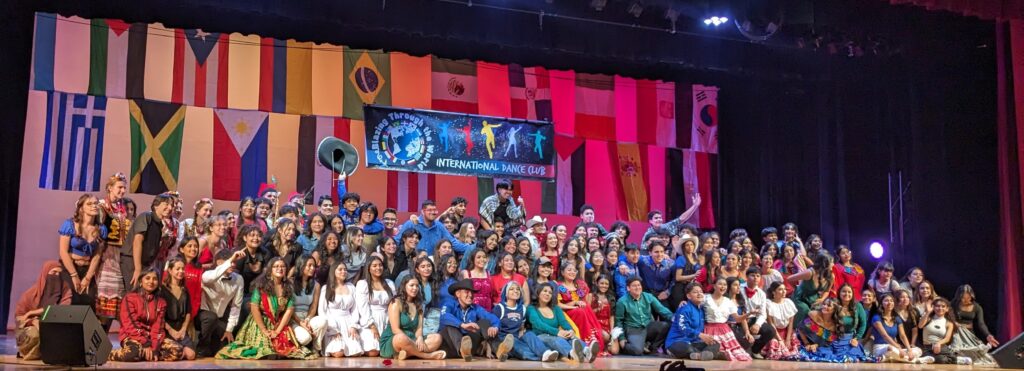Capping off a festive International Week, AT hosted its annual International Fest; Kicking off a week celebration of all different cultures culminating in one community here at AT.
To celebrate, International Fest held its own spirit week and put up decorations all around the school. Events on each of the days consisted of pajama day, wearing flag colors, bringing anything but a backpack, and wearing cultural apparel. The windows in the commons were also filled with several flags of different countries.
AT also held its annual Dec-A-Door competition where each ATR decorated a door to represent countries. Judges then look at each door and give it a grade based on a rubric. The top 3 doors are announced as the winners for that year.
For the duration of the week, international music from several cultures was played during passing periods. Many students also created and presented their stories about international travels or exchange programs throughout the school.
All of these events culminated in creating an ecstatic and lively atmosphere for the International Dance performance. The dance featured many different cultures and let Blazers take the central stage.
Each dance featured in the show was run by student leaders and went on their schedule. This flexibility allowed many of their groups to focus on their dances and worries before all coming together to practice on the stage for the week before the show.
However much preparation had to be put in to deliver the final product. Many groups started to look for members in September with practices starting in October. This time also allowed many groups to be accustomed to their dance and the culture associated with it. Antonina Pecoraro said, “I feel connected with the dances and I think it’s interesting and beautiful to be a part of a culture that I’m usually not.”
Camilla Esparza, a member of the Bachata, Merengue, and Plena dances, took time to research the culture of her dances and found “Two of the dances I’m in were created by people in the Dominican Republic so I really love and appreciate their culture. I’ve learned that Dominicans popularized Merengue in the city of Santiago in the 1800s.”
Taking an alternative form of research, a member of the K-pop and American pop dance Ximena Castillo was able to visit the country that was associated with her dance. “With K-pop, since I visited Korea last year I feel like I learned a lot about its culture and now I am able to dance to K-pop music which I am happy about,” said Castillo.
Having a connection to the culture aids in performing and understanding the dance but having a connection to dancing also has its benefits. Leader of the K-pop dance, Hip-Hop dance, and President of Energy Rush Yadira Avila, “I found my passion for dancing in 5th grade. When I heard about International Dances my 8th grade year I felt so excited to join. My old sponsors made it really enjoyable considering it was my first showcase.”
Considerable effort and dedication have also been required to keep the show up to the highest of standards. Many groups held hour-long or more practices on multiple days out of the week. This also allowed groups to build a connection with their fellow members.
“The practices are fun, and the atmosphere of my group is very funny. The dancers in my groups love to joke around but when it’s time to dance they do it well,” said Esparza.
Although sometimes it takes more effort to have everyone at a single practice than expected. Leader of the Indian dance group Chellarani Muthukumaran said “Practices are very fun, usually as we just hang out. It is sometimes a little frustrating trying to get everyone together to teach them, however, it is very chill and we get to know each other better.”
Outfits are also a vital aspect to each of the dances. Dancers usually don costumes and colors that represent the culture of their dance. The costumes however can also be a struggle and more work on leaders to learn about the culture and traditional costumes. “We had to do more research on the traditional side for Buchaechum. The hanboks and fans were very pretty and I think they came all together for the dance. The hanboks are traditional Korean dresses mainly worn for special events,” said Avila.
Experience is also not necessary for many of the dances. Many of the dances openly welcome new participants and are happy to see the growth of the International Fest as a whole group. “I don’t have any past experience with dancing but the leaders are good at teaching so I was able to learn the dances easily,” said Castillo. “My friends encouraged me to join because they were part of it last year and they said it was so much fun.”
Many groups were still working on perfecting their dances up to the night of the show. However, dancers also expressed having nerves and plenty of excitement before the show started and hoped that it would go well. Talking before the performance Pecoraro said, “I’m very nervous for the show, performing in front of a whole audience is not for the weak. I am excited but the closer it gets, the more nervous I am.”
Through the many opportunities given during International Fest, many students have been able to connect with their own culture along with the ones of their friends and other students. Events like these pave the way forward to connecting AT as one community and for students to embrace who they are.

